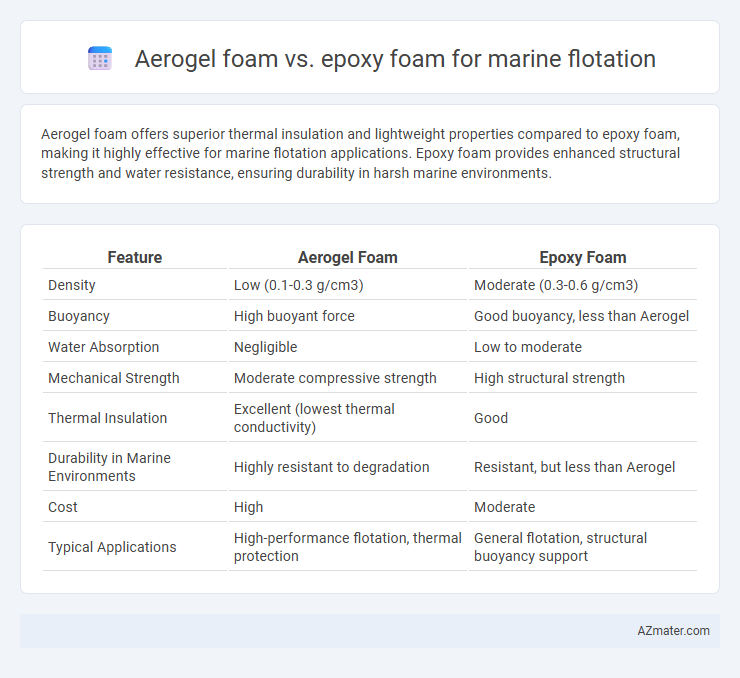Aerogel foam offers superior thermal insulation and lightweight properties compared to epoxy foam, making it highly effective for marine flotation applications. Epoxy foam provides enhanced structural strength and water resistance, ensuring durability in harsh marine environments.
Table of Comparison
| Feature | Aerogel Foam | Epoxy Foam |
|---|---|---|
| Density | Low (0.1-0.3 g/cm3) | Moderate (0.3-0.6 g/cm3) |
| Buoyancy | High buoyant force | Good buoyancy, less than Aerogel |
| Water Absorption | Negligible | Low to moderate |
| Mechanical Strength | Moderate compressive strength | High structural strength |
| Thermal Insulation | Excellent (lowest thermal conductivity) | Good |
| Durability in Marine Environments | Highly resistant to degradation | Resistant, but less than Aerogel |
| Cost | High | Moderate |
| Typical Applications | High-performance flotation, thermal protection | General flotation, structural buoyancy support |
Introduction to Marine Flotation Materials
Aerogel foam and epoxy foam are prominent materials used in marine flotation due to their exceptional buoyancy and durability. Aerogel foam offers superior thermal insulation and lightweight properties, making it ideal for applications requiring minimal weight and enhanced energy efficiency. Epoxy foam excels in structural strength and water resistance, providing robust support and longevity in harsh marine environments.
What is Aerogel Foam?
Aerogel foam is an ultralight, highly porous material composed of silica or other substances, known for its exceptional thermal insulation and buoyancy properties, making it ideal for marine flotation applications. Its low density and high porosity enable superior water resistance and durability compared to traditional foams like epoxy foam. In marine environments, aerogel foam provides enhanced flotation efficiency while maintaining structural integrity under harsh conditions.
What is Epoxy Foam?
Epoxy foam is a lightweight, rigid material composed of a polymer resin matrix reinforced with cellular structure, widely used for marine flotation due to its excellent water resistance, high compressive strength, and durability in harsh marine environments. Its closed-cell structure prevents water absorption, making it ideal for buoyancy applications in boats, docks, and flotation devices. Compared to aerogel foam, epoxy foam offers superior mechanical strength and impact resistance, though it generally has higher density and less thermal insulation properties.
Key Properties Comparison: Aerogel vs Epoxy Foam
Aerogel foam exhibits ultra-low density and superior thermal insulation, making it highly effective for marine flotation by reducing overall weight and enhancing buoyancy. Epoxy foam offers excellent mechanical strength and durability, providing robust impact resistance and long-term stability in harsh marine environments. Both materials demonstrate distinct advantages, with aerogel providing enhanced insulation and lightness, while epoxy foam ensures structural integrity and resistance to water absorption.
Buoyancy Performance in Marine Environments
Aerogel foam exhibits superior buoyancy performance in marine environments due to its ultra-low density and high porosity, providing exceptional water resistance and minimal water absorption compared to epoxy foam. Epoxy foam offers moderate buoyancy but tends to absorb more water over time, reducing its effectiveness and increasing weight in prolonged marine exposure. The enhanced buoyancy retention of aerogel foam makes it a preferred choice for marine flotation devices requiring long-term durability and stability.
Water Absorption and Moisture Resistance
Aerogel foam exhibits exceptional water absorption resistance due to its hydrophobic properties and ultra-low density, making it highly effective for marine flotation applications where minimal moisture uptake is critical. In contrast, epoxy foam typically demonstrates higher water absorption rates, leading to potential degradation and reduced buoyancy over time in marine environments. The superior moisture resistance of aerogel foam ensures prolonged durability and performance compared to epoxy foam in saltwater and high-humidity conditions.
Durability and Longevity at Sea
Aerogel foam offers superior thermal insulation and resistance to water absorption, enhancing durability and longevity in marine flotation applications compared to epoxy foam. Epoxy foam, while providing strong structural support, tends to degrade faster under prolonged exposure to saltwater and UV radiation, reducing its lifespan. The hydrophobic nature and low density of aerogel foam contribute to maintaining buoyancy and structural integrity over extended periods at sea.
Weight and Structural Impact
Aerogel foam offers exceptionally low density, significantly reducing weight compared to epoxy foam, making it ideal for marine flotation where buoyancy and minimized weight are critical. Its low thermal conductivity and compressive strength provide durable flotation without compromising structural integrity. Epoxy foam, while heavier, offers higher rigidity and impact resistance but may increase overall vessel weight, affecting fuel efficiency and handling.
Cost Analysis and Practical Considerations
Aerogel foam offers superior buoyancy and thermal insulation for marine flotation but comes with a significantly higher initial cost compared to epoxy foam, which is more economically viable for large-scale applications. Epoxy foam provides adequate buoyancy and structural integrity while being easier to apply and repair, reducing labor costs and downtime. Practical considerations include the durability of epoxy foam in harsh marine environments, whereas aerogel's fragility and cost limit its use to specialized, high-performance flotation needs.
Best Applications: Choosing the Right Foam for Marine Flotation
Aerogel foam offers exceptional thermal insulation and water resistance, making it ideal for marine flotation in cold or harsh environments where buoyancy and temperature control are critical. Epoxy foam provides superior structural strength and impact resistance, suited for applications requiring durable, rigid flotation devices and hull reinforcements. Selecting between aerogel and epoxy foam depends on the need for lightweight, insulating properties versus robust mechanical support in marine conditions.

Infographic: Aerogel foam vs Epoxy foam for Marine flotation
 azmater.com
azmater.com